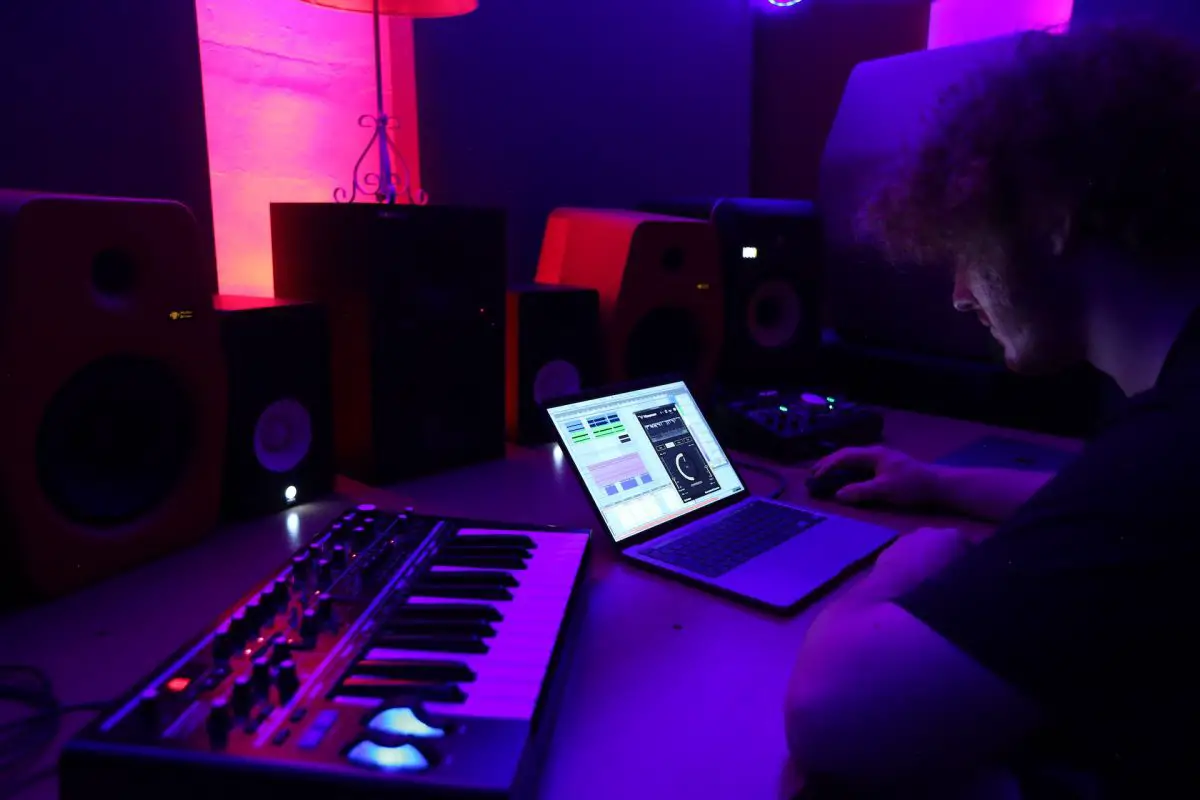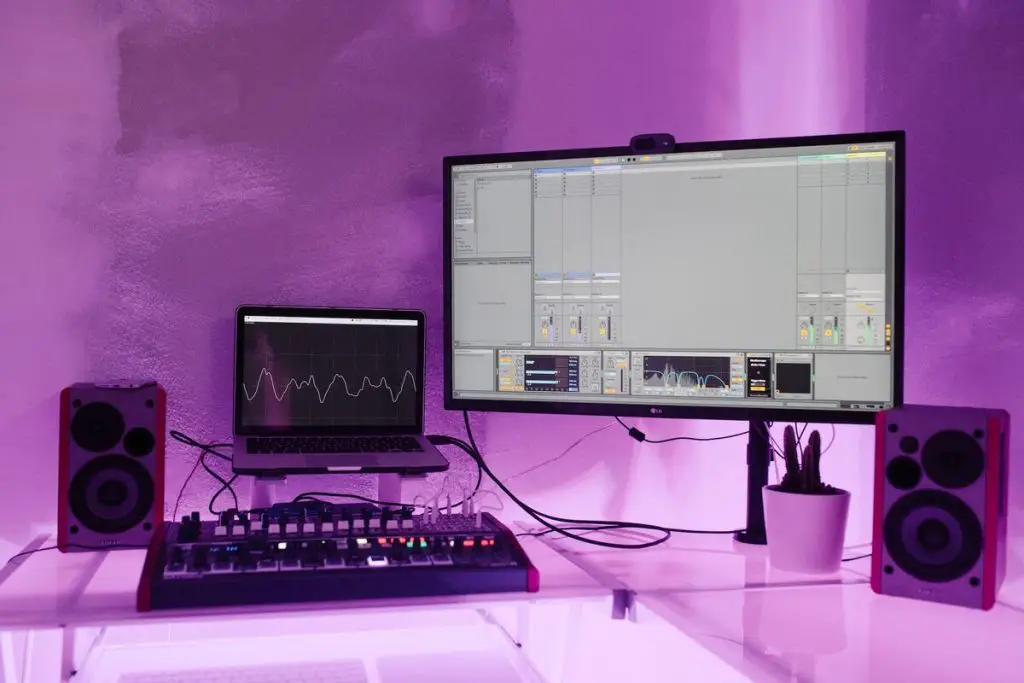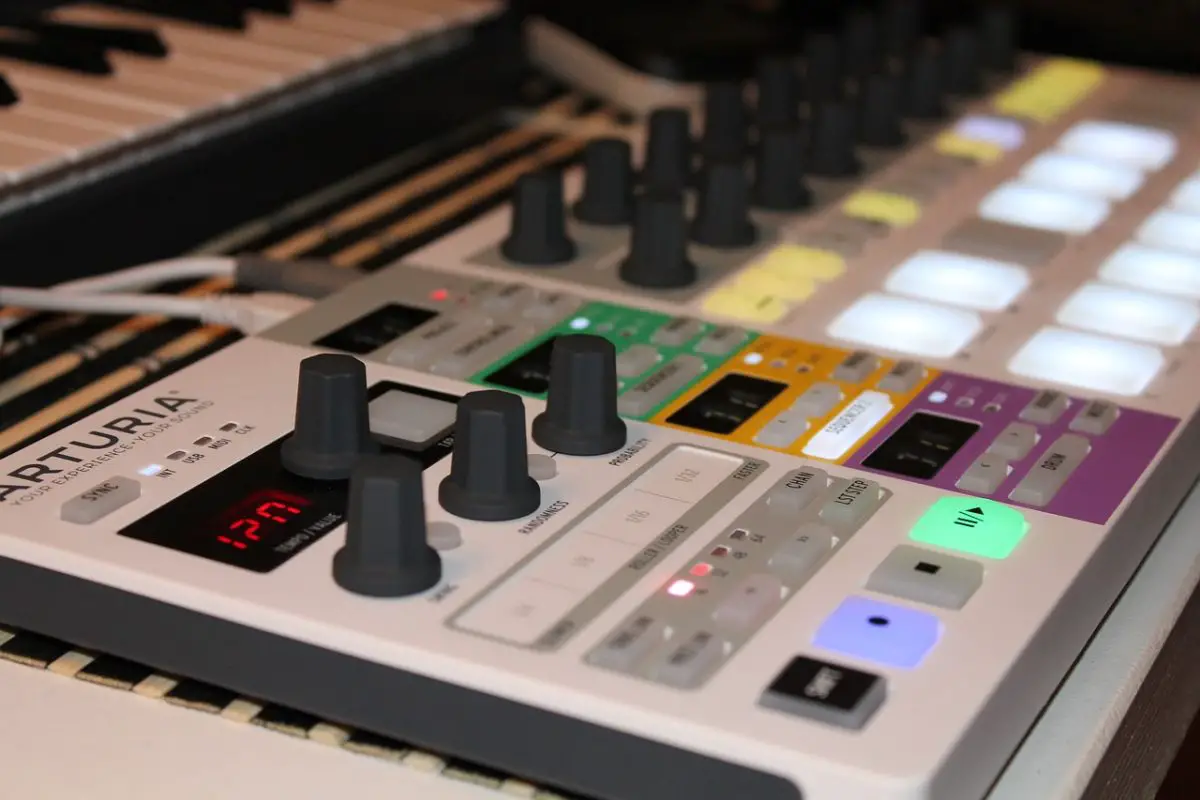Remember that time you stumbled upon a new sound that blew your mind and left you craving for more? Well, that’s how I felt when I first heard about granular synthesis. So, what exactly is granular synthesis? By the end of this blog post, you’ll have a grasp of this technique and its importance in music production. Plus, you’ll learn how to granulate your own tracks and create some “grains” in your music.
What is granular synthesis? Granular synthesis is a technique in sound design and music production that involves breaking down an audio signal into small segments called “grains” and then reassembling them to create new, complex sounds and textures.
What is granular synthesis?
Granular synthesis is a method of morphing sound without affecting playback speed. It operates on the microsound time scale, usually in the range of 1 to 50 milliseconds. The sound is broken down into small chunks, or “grains,” each of which may be only a few milliseconds long. These grains can be layered, processed, and rearranged in various ways to manipulate or create new sounds.

This unique approach to synthesis allows for the creation of sounds that were once impossible to achieve with traditional synthesis methods.
Granular synthesis is a game-changer in the world of sound design and music production. It allows you to craft intricate, otherworldly sounds by manipulating tiny grains of an audio sample. This unique approach to synthesis allows for the creation of sounds that were once impossible to achieve with traditional synthesis methods.
Let’s take a simple piano note, for example. By breaking it down into grains and reassembling them in various ways, you can create a vast array of sonic textures. From a shimmering, ethereal pad to an aggressive, glitchy lead.
AKAI Professional MPK Mini MK3

AKAI Professional MPK Mini MK3
What are the key aspects of granular synthesis?
One of the most exciting aspects of granular synthesis is the ability to modulate the position, length, and pitch of grains. This modulation adds movement and variation to the sound, making it dynamic and engaging. By tweaking these parameters, you can transform a simple sound into a complex and evolving sonic landscape.
This technique, known as creating a “grain cloud,” generates a swirling, atmospheric effect…
Imagine playing back multiple grains of a source sample simultaneously. This technique, known as creating a “grain cloud,” generates a swirling, atmospheric effect that’s reminiscent of fluffy clouds floating through the sky. By layering and manipulating these grain clouds, you can achieve ambient tones and ethereal textures that transport your listeners to a whole new sonic dimension.
Randomization is a powerful tool in granular synthesis that allows you to introduce unpredictable and unusual changes in your sound. Whether it’s subtle variations or overt randomness, this feature adds an element of surprise and experimentation. Embrace the unexpected and let your sound take on a life of its own.
How does granular synthesis work?
As we’ve mentioned before, it all comes down to breaking an audio sample into minuscule segments called “grains.” These grains can be as short as a few milliseconds or as long as a few hundred milliseconds. Once you’ve got your grains, the real fun begins – manipulating and reassembling them to create entirely new sounds.
To give you a better idea of how granular synthesis works, let’s dive into the process step by step:
- Choose an audio sample: Pick a sound you’d like to manipulate. It can be anything from a single note to a complex recording.
- Break it down into grains: Use granular synthesis software or hardware to slice the sample into tiny pieces, each with a specific duration, pitch, and amplitude.
- Manipulate the grains: Adjust parameters like grain size, pitch, amplitude, and panning. You can also control how the grains are played back, such as in a loop, randomly, or even in reverse.
- Reassemble the grains: The software or hardware reassembles the manipulated grains, creating a new sound that still contains the original sample’s characteristics but with a completely different “texture.”
Why is granular synthesis important in music production?
You might be wondering, “Why should I bother with granular synthesis when there are so many other techniques and tools available?” Well, the answer is simple: granular synthesis offers unparalleled creative possibilities that can help you stand out in the competitive world of music production.

Here are a few reasons why you should consider adding granular synthesis to your music production toolkit:
- Unique soundscapes: Granular synthesis lets you create one-of-a-kind textures and atmospheres that can’t be replicated using traditional synthesis methods. This can give your music a distinct, memorable quality that sets it apart from the rest.
- Experimentation and discovery: The process of breaking down and reassembling audio opens up a vast playground for experimentation. You can explore new sonic territories and stumble upon unexpected sounds that can inspire your music production.
- Enhanced sound design: Granular synthesis is a powerful sound design tool that can help you craft custom sounds tailored to your specific needs, whether it’s a subtle effect for a film score or an in-your-face synth lead for an EDM track.
- Adaptable to various genres: From ambient and experimental to pop and electronic, this technique can be used to create unique sounds that elevate your productions.
What are the key aspects of granular synthesis?
One of the most exciting aspects of granular synthesis is the ability to modulate the position, length, and pitch of grains. This modulation adds movement and variation to the sound, making it dynamic and engaging. By tweaking these parameters, you can transform a simple sound into a complex and evolving sonic landscape.
This technique, known as creating a “grain cloud,” generates a swirling, atmospheric effect…
Imagine playing back multiple grains of a source sample simultaneously. This technique, known as creating a “grain cloud,” generates a swirling, atmospheric effect that’s reminiscent of fluffy clouds floating through the sky. By layering and manipulating these grain clouds, you can achieve ambient tones and ethereal textures that transport your listeners to a whole new sonic dimension.
Randomization is a powerful tool in granular synthesis that allows you to introduce unpredictable and unusual changes in your sound. Whether it’s subtle variations or overt randomness, this feature adds an element of surprise and experimentation. Embrace the unexpected and let your sound take on a life of its own.
What tools and software can you use for granular synthesis?
Now that you’re all pumped up about granular synthesis, you’re probably itching to dive in and start creating those mind-bending sounds yourself. Here’s a list of some popular granular synthesis tools to help you jumpstart your journey:
- Granulator II by Ableton: If you’re an Ableton Live user, this Max for Live device is a must-have. Developed by musician and programmer Robert Henke, Granulator II is a versatile and powerful granular synthesizer that allows you to explore a wide range of granular techniques.
- Padshop by Steinberg: Padshop is a virtual instrument dedicated to granular synthesis. It comes with two granular engines and a vast library of presets, giving you endless possibilities for crafting unique textures and sounds.
- The Mangle by Sound Guru: This granular synth plugin offers a visual, intuitive interface that makes it easy for beginners to dive into granular synthesis. The Mangle is especially great for creating evolving, organic textures.
- Quanta by Audio Damage: Quanta is a flexible, granular synthesizer that works as a standalone application or a plugin for your favorite DAW. It boasts a clean, user-friendly interface and a wide array of modulation options.
- Granulizer 2 by Inertia Sound Systems: Granulizer 2 is a granular synthesis plugin that focuses on real-time manipulation and experimentation. It offers various grain generation modes, giving you full control over your sound design process.

What are some recommended granular synths plugins?
If you’re more inclined towards the digital domain, fear not! Granular synthesis has found its place in the realm of plugins too. Here are some top-notch granular synths available as plugins:
- Alchemy (Logic): For Logic users, the built-in synth Alchemy provides a treasure trove of granular synthesis capabilities. Explore its vast library of sounds and unleash your creativity with its granular synthesis engine. Dive deep into sound design and create unique textures that will captivate your audience.
- Max-powered Granulator II (Ableton Live Suite): Ableton Live Suite owners have a powerful granular tool at their disposal called Granulator II. Powered by Max, it offers an array of granular synthesis features that will add depth and character to your music. Dive into the world of granular manipulation, experiment with different source materials, and craft sonic masterpieces.
- Grain (Reason): Reason users can tap into the excellent Grain device for their granular synthesis needs. Grain offers an intuitive interface and a wealth of sound sculpting options. Dive into your own collection of samples, slice them into grains, and mold them into sonic landscapes that reflect your unique artistic vision.
Advantages and disadvantages of granular synthesis
Granular synthesis, like any synthesis method, has its own set of advantages and disadvantages that make it better suited for some applications than others:
Advantages of granular synthesis
- Flexibility and Variety: Granular synthesis allows for a wide range of sound manipulation, from subtle changes to dramatic transformations. This makes it highly versatile in sound design and music production.
- Time Stretching Without Pitch Change: One unique aspect of granular synthesis is the ability to greatly extend the length of a sound without changing its pitch or causing it to sound unnatural.
- Sound Morphing: Granular synthesis can be used to blend or morph between different sounds, creating smooth transitions or hybrid sounds.
Disadvantages of granular synthesis
- Complexity: Granular synthesis can be complex to understand and manipulate. It can take a lot of experimentation and learning to get the results you want.
- Unpredictability: Because it operates on such a small scale, the results of granular synthesis can sometimes be unpredictable. Small changes in parameters can lead to big changes in sound.
- CPU Intensive: Granular synthesis can be computationally intensive, which means it may put a significant load on your computer’s processor. This could be an issue in a complex project with many tracks or plugins.
- Not Suitable for All Sounds: While granular synthesis can produce fascinating and complex sounds, it might not be the best choice for more straightforward or traditional sounds. Traditional subtractive, additive, or FM synthesis might be more suitable for these tasks.
If you want even more tips and insights, watch this video called “Granular Synthesis Explained” from the White Noises YouTube channel.
Frequently asked questions (FAQ)
Do you still have questions about granular synthesis? Below are some of the most commonly asked questions.
Can I use granular synthesis with any type of sound or sample?
Absolutely! Granular synthesis can be applied to most sounds or samples, regardless of their origin or nature. This makes it an incredibly versatile technique for sound design and music production. However, keep in mind that it might not be the best choice for more straightforward or traditional sounds. Traditional subtractive, additive, or FM synthesis might be more suitable for these tasks.
Do I need special hardware for granular synthesis?
While some hardware synthesizers offer granular synthesis capabilities, you don’t necessarily need specialized hardware. Most granular synthesis can be done using software and plugins on your computer within your favorite digital audio workstation (DAW).
Is granular synthesis suitable for beginners?
Granular synthesis can be intimidating for beginners, but don’t let that discourage you! With the right tools and some patience, even a newbie can start exploring this fascinating technique. Start with user-friendly software and gradually work your way into more advanced options as you become comfortable.
Can I use granular synthesis on any type of audio file?
Granular synthesis can be applied to a wide range of audio files, including vocal recordings, instrument samples, field recordings, and even synthesized sounds. As long as you have a source audio file, you can experiment with granular synthesis techniques to transform and manipulate the sound.
Is granular synthesis suitable for live performances?
Absolutely! Granular synthesis can be an exciting addition to live performances, allowing you to create dynamic and evolving textures in real time. Many granular synthesis plugins and hardware devices offer performance-friendly features that make it easy to integrate into your live setup.
Can I use granular synthesis in genres other than electronic music?
Certainly! While granular synthesis has its roots in electronic music, its applications extend to various genres. From ambient and experimental to rock, pop, and beyond, granular synthesis can add a unique touch to any musical style, enabling you to craft distinctive sounds and textures.
Conclusion
Well, there you have it, folks – the grains of wisdom about granular synthesis! I hope this article has shed some light on this powerful and exciting technique. So, did I cover everything you wanted to know? Let me know in the comments section below. I read and reply to every comment. If you found this article helpful, share it with a friend, and check out my full blog for more tips and tricks on music production. Thanks for reading, and keep on making those sonic waves!
Key takeaways
This article covered the fascinating world of granular synthesis. Here are some key takeaways:
- Granular synthesis is a technique that involves breaking sound into tiny grains and reassembling them to create new textures and sounds.
- It can be used for sound design, creating unique soundscapes, and enhancing music production across various genres.
- There are many tools and software options available for granular synthesis, catering to different skill levels and budgets.
- Granular synthesis has its advantages and disadvantages, but when used thoughtfully, it can be a powerful tool for transforming your music production.
- It offers applications in sound design, vocal processing, instrument manipulation, and more.
- Recommended granular synths include Mutable Instruments Beads, Make Noise Morphagene, and Qu-Bit Nebulae.
- Granular synthesis provides both advantages, such as unique sound design possibilities, and considerations like processing power and sample selection.















